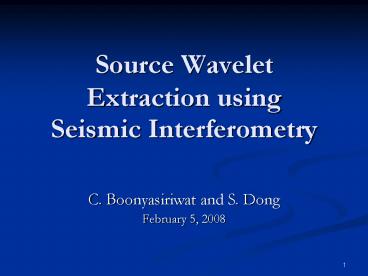Source Wavelet Extraction using Seismic Interferometry - PowerPoint PPT Presentation
1 / 25
Title:
Source Wavelet Extraction using Seismic Interferometry
Description:
Source Wavelet Extraction using Seismic Interferometry ... It s because we also need an accurate source wavelet for VSP data processing: deconvolution, ... – PowerPoint PPT presentation
Number of Views:308
Avg rating:3.0/5.0
Title: Source Wavelet Extraction using Seismic Interferometry
1
Source Wavelet Extraction usingSeismic
Interferometry
- C. Boonyasiriwat and S. Dong
- February 5, 2008
2
Outline
- Goal and Motivation
- Theory
- Numerical Results
- SSP (Surface Seismic Profile) Synthetic Data
- SSP North Sea Data
- VSP (Vertical Seismic Profile) Synthetic Data
- Summary
- Future Work
3
Goal
- To estimate a seismic source signature.
4
Motivation
- seismic migration/interpretation
5
Outline
- Goal and Motivation
- Theory
- Numerical Results
- SSP (Surface Seismic Profile) Synthetic Data
- SSP North Sea Data
- VSP (Vertical Seismic Profile) Synthetic Data
- Conclusion
- Future Work
6
Theory
- Behura (SEG 2007) presented the Virtual Real
Source method to extract the source wavelet from
SSP synthetic data.
- This method is based on Seismic Interferometry
using the reciprocity equation of correlation
type.
- Assumptions no attenuation and source signature
is the same for all shots.
7
Theory
Virtual SSP Primary W(?)2G(BA)
SSP Primary W(?)G(As)
SSP Multiple W(?)G(Bs)
8
Theory
- Virtual CSG
- Real CSG
9
Outline
- Goal and Motivation
- Theory
- Numerical Results
- SSP (Surface Seismic Profile) Synthetic Data
- SSP North Sea Data
- VSP (Vertical Seismic Profile) Synthetic Data
- Conclusion
- Future Work
10
Numerical Results
- SSP Synthetic Data
- 10-Layer Model
- Mapleton Model
- SSP North Sea Data
- VSP Synthetic Data
11
10-Layer Model
12
Original CSG vs Virtual CSG
13
True Source vs Extracted Source
14
Mapleton Model
15
Original CSG vs Virtual CSG
16
True Source vs. Extracted Source
17
Numerical Results
- SSP Synthetic Data
- 10-Layer Model
- Mapleton Model
- SSP North Sea Data
- VSP Synthetic Data
17
18
North Sea Data
- There are 515 shots with 480 hydrophones per
shot. - The shot interval is 37.5 m and the hydrophone
interval is 12.5 m. - The time sampling rate is 2 ms and the total
record time is 10 s.
19
North Sea Data
120 Hydrophones
1001 Shots
dt 4 ms Tmax 6 s
20
Original CSG vs. Virtual CSG
21
North Sea Extracted Source Wavelet
22
Air-gun Source Signature (at 300 m)
23
Numerical Results
- SSP Synthetic Data
- 10-Layer Model
- Mapleton Model
- SSP North Sea Data
- VSP Synthetic Data
23
24
Motivation for VSP Case
- Why extract a VSP source wavelet?
- Its because we also need an accurate source
wavelet for VSP data processing deconvolution,
migration, improving spatial resolution.
25
Simple VSP Model
VSP
26
Original VSP CSG vs Virtual VSP CSG
27
True Source vs. Extracted Source
28
Outline
- Goal and Motivation
- Theory
- Numerical Results
- SSP (Surface Seismic Profile) Synthetic Data
- SSP North Sea Data
- VSP (Vertical Seismic Profile) Synthetic Data
- Summary
- Future Work
29
Summary
- Seismic interferometry can provide a good
estimate of a source wavelet from seismic data
without subsurface information. - The source signature is assumed to be the same
for every shot and there is no attenuation. - The minimum phase assumption is not required.
- The accuracy of the wavelet estimate degrades
with decreasing source aperture.
30
Future Work
- Test on the variation of source wavelets, e.g.,
varying amplitude and phase spectra. - Apply this method to VSP field data.
- Estimate a source radiation pattern.































